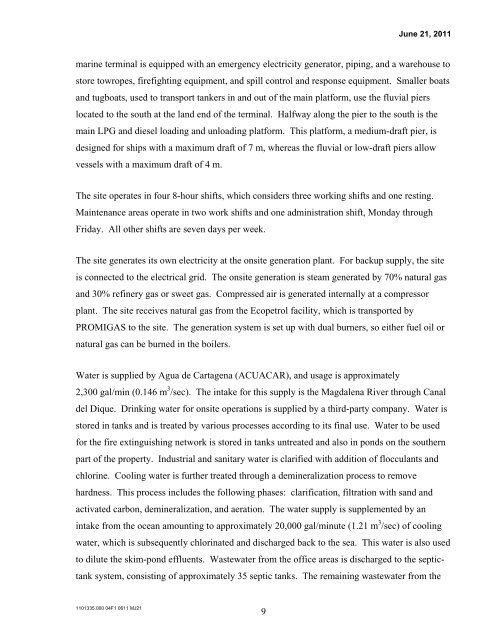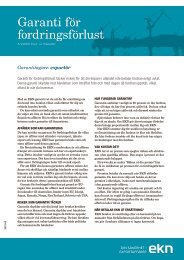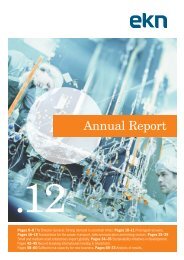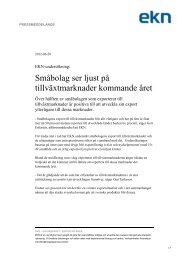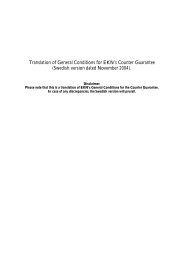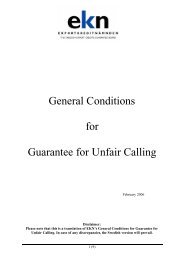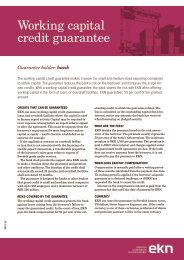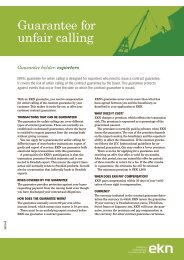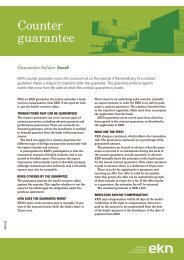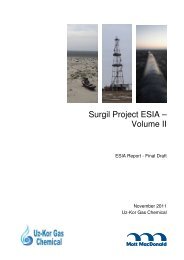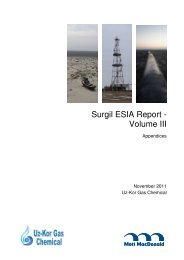Reficar Cartagena Refinery Expansion, Colombia - EKN
Reficar Cartagena Refinery Expansion, Colombia - EKN
Reficar Cartagena Refinery Expansion, Colombia - EKN
You also want an ePaper? Increase the reach of your titles
YUMPU automatically turns print PDFs into web optimized ePapers that Google loves.
1101335.000 04F1 0611 MJ21<br />
9<br />
June 21, 2011<br />
marine terminal is equipped with an emergency electricity generator, piping, and a warehouse to<br />
store towropes, firefighting equipment, and spill control and response equipment. Smaller boats<br />
and tugboats, used to transport tankers in and out of the main platform, use the fluvial piers<br />
located to the south at the land end of the terminal. Halfway along the pier to the south is the<br />
main LPG and diesel loading and unloading platform. This platform, a medium-draft pier, is<br />
designed for ships with a maximum draft of 7 m, whereas the fluvial or low-draft piers allow<br />
vessels with a maximum draft of 4 m.<br />
The site operates in four 8-hour shifts, which considers three working shifts and one resting.<br />
Maintenance areas operate in two work shifts and one administration shift, Monday through<br />
Friday. All other shifts are seven days per week.<br />
The site generates its own electricity at the onsite generation plant. For backup supply, the site<br />
is connected to the electrical grid. The onsite generation is steam generated by 70% natural gas<br />
and 30% refinery gas or sweet gas. Compressed air is generated internally at a compressor<br />
plant. The site receives natural gas from the Ecopetrol facility, which is transported by<br />
PROMIGAS to the site. The generation system is set up with dual burners, so either fuel oil or<br />
natural gas can be burned in the boilers.<br />
Water is supplied by Agua de <strong>Cartagena</strong> (ACUACAR), and usage is approximately<br />
2,300 gal/min (0.146 m 3 /sec). The intake for this supply is the Magdalena River through Canal<br />
del Dique. Drinking water for onsite operations is supplied by a third-party company. Water is<br />
stored in tanks and is treated by various processes according to its final use. Water to be used<br />
for the fire extinguishing network is stored in tanks untreated and also in ponds on the southern<br />
part of the property. Industrial and sanitary water is clarified with addition of flocculants and<br />
chlorine. Cooling water is further treated through a demineralization process to remove<br />
hardness. This process includes the following phases: clarification, filtration with sand and<br />
activated carbon, demineralization, and aeration. The water supply is supplemented by an<br />
intake from the ocean amounting to approximately 20,000 gal/minute (1.21 m 3 /sec) of cooling<br />
water, which is subsequently chlorinated and discharged back to the sea. This water is also used<br />
to dilute the skim-pond effluents. Wastewater from the office areas is discharged to the septictank<br />
system, consisting of approximately 35 septic tanks. The remaining wastewater from the


